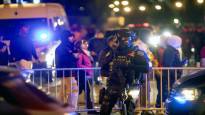The threat of terror returned to Europeans’ daily lives overnight, when the extremist organization Hamas attacked Israel from Gaza, and Israel began to destroy Hamas in retaliation. This is what the experts interviewed by say.
Attacks in Europe have been and will be carried out by individual actors.
– We will see attacks similar to knife attacks or car attacks in recent years. Simple, improvised attacks, predicts the security professor Peter Neumann from King’s College London.
Neumann is also a researcher at the International Center for the Study of Radicalization (ICSR). He is one of Europe’s best-known experts on radicalization.
In Europe, there have been several attacks against Jews and synagogues in the last couple of weeks. Neumann says that we will see more of these.
Attacks are provoked, for example, by images that come from Gaza. They have seen how the bodies of civilians have been dug up from the ruins of houses that collapsed in rocket attacks.
– I believe that this is just the beginning. There have only been a few weeks of war in Israel and Gaza, and more gruesome pictures and videos are coming. They radicalize.
There is also a lot of wrong material in circulation. Some of the images circulating on social media are fake or taken from previous conflicts.
The attacks in Paris, Brussels, Nice and Berlin in the last decade left a memory mark on many Europeans, and now those memories can come back.
During the corona, there were hardly any terrorist attacks. Traveling was difficult and there were no large crowds. There were small knife attacks in Europe even then.
However, terrorism and terrorists did not disappear anywhere in the meantime, the researchers remind.
– Jihadist terrorist networks came here in the 21st century, and they remained a permanent phenomenon, says Tarja Mankkinen.
Mankkinen is a project manager in the radicalization prevention unit at the EU Commission.
In Finland, the small shocks of the past few weeks have hardly made the news. That’s why the image of Finns can be wrong.
– My understanding is that Finland has started to believe that the threat of terrorism no longer exists, says Tarja Mankkinen.
Knife attack, terrorist arrests, bomb threats
The attacks of the last few weeks are united by the fact that the perpetrators are jihadists, i.e. extreme Islamists.
Here are some examples: In Arras, France, a former student of the school wounded several and killed a teacher on October 13. The student was a radicalized Islamist and was being followed by the police.
In Belgium, an ISIS terrorist killed two Swedish soccer tourists and wounded a third on October 16. He was of Tunisian background and under police surveillance. The motive was Swedish hatred. Arrests have also been made in France in connection with the attack.
In Germany, France and Belgium, there have been dozens of bomb threats at schools, airports and, for example, at the German public broadcasting company ZDF. In Berlin, a synagogue was hit with petrol bottles.
The cases have originated directly or indirectly from the situation in the Middle East.
European cities have also seen large demonstrations, in connection with which petrol bottle attacks have been seen. The movement includes those who are provoked by the situation in Gaza: jihadists, other Muslim communities, and the extreme left, which considers Israel its enemy, Neumann lists.
Some groups are violent, some are not.
Isis wants to come out again
Isis, or the network of terrorists born in Iraq and Syria, initially did not take a position on the attack by Hamas.
– Neither condemned nor cheered, says Professor Neumann.
However, the events in Gaza have grown so big and received so much attention that Isis also wants to be part of the phenomenon and calls to support the Palestinians, explains Neumann.
He estimates that the decline of ISIS has discouraged and held back individual actors from striking in recent years.
– Now they suddenly see a new opportunity where Isis can get involved again, Neumann estimates.
Mankkinen, who works at the EU Commission in Brussels, says that he has been waiting for something to happen for a long time.
– It may be that ISIS has to try to strike in order to keep it in people’s minds and as a fear in Europe.
We are trying to get more and more young people involved
We hardly see attacks planned by large groups anymore, but individual actors who have become radicalized online.
According to Neumann, some of the imams, who ten years ago were driving attackers wild in mosques, have moved to the Internet.
Many of the radicalized are only teenagers.
– On the Internet, violent groups aim their propaganda at minors and recruit them. The youngest are only a little over 10 years old, says Mankkinen.
The special feature of the corona era was the conspiracy theories spreading on the internet. The core of many of them is anti-Jewish. In Muslim countries, on the other hand, false information has been spread for a couple of years that social workers kidnap children from Muslim families in Sweden.
So far, the extreme right has not been involved in attacks inspired by events in the Middle East. But researchers suspect that once enough jihadists are on the move, the far right will rear its head.
– Then the political debate in European societies can become even uglier than it is now.
The purpose of the perpetrators of terrorist attacks is to arouse fear and threaten people’s freedom and sense of security.
The authorities are constantly removing radicalizing material from the internet. According to Neumann, the right things are already being done to prevent attacks, but they need to be done more, especially online.
